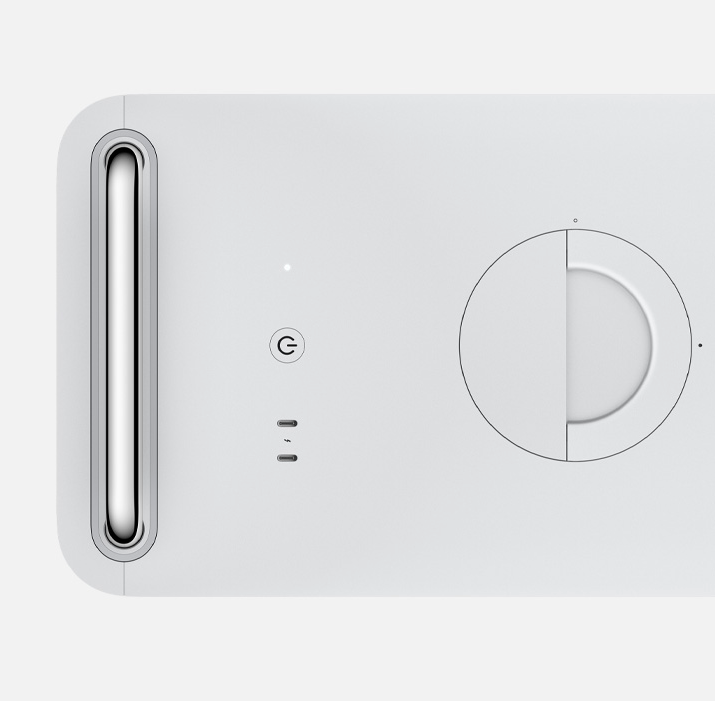
The Mac Pro is Apple’s flagship desktop, offering unparalleled power, flexibility, and expandability for professionals who require the utmost in performance. Whether you’re a video editor, music producer, graphic designer, or a developer working with resource-intensive applications, the Mac Pro stands out as a workhorse capable of handling the most demanding tasks. With its robust design and modular architecture, it has become the go-to solution for studios, creative agencies, and enterprises requiring a custom-tailored workstation.
Performance:
1. Powerful Processor Options:
The Mac Pro is available with a variety of processor configurations, featuring Intel Xeon W-series processors. You can choose from 8, 12, 16, 24, or 28 cores, making it an extremely powerful machine. The higher-core models excel in multi-threaded workloads like 3D rendering, large-scale data analysis, and high-end video editing. While Apple has shifted to its own M-series chips in many devices, the Mac Pro remains Intel-based, which appeals to users who need maximum CPU power and flexibility.
2. GPU and Graphics Performance:
The Mac Pro offers extensive GPU options, including the ability to install up to two AMD Radeon Pro GPUs, with configurations offering up to 56 teraflops of compute performance. This makes the Mac Pro an excellent choice for creative professionals working with 3D graphics, visual effects, or high-end video production. The sheer graphics performance of the Mac Pro allows for real-time rendering, smooth playback, and the ability to work with high-resolution footage, such as 8K video.
3. Memory (RAM):
The Mac Pro supports up to 1.5TB of DDR4 ECC (Error Correcting Code) memory, which is ideal for memory-intensive tasks such as scientific simulations, virtual machines, and professional video editing. The flexibility to configure RAM based on your specific needs makes the Mac Pro an incredibly versatile machine. However, this high RAM capacity comes at a premium cost, making the Mac Pro a serious investment.
4. Storage and Expandability:
The Mac Pro offers multiple storage configurations, starting with a 256GB SSD, but users can upgrade to as much as 8TB of SSD storage. The SSDs are incredibly fast, ensuring quick boot times, rapid file transfers, and the ability to handle large media files with ease. Additionally, the Mac Pro’s modular design allows users to expand storage through PCIe expansion slots, which is a key benefit for professionals who require specialized hardware like RAID cards or additional GPUs.
5. Mac Pro’s Expansion Potential:
One of the defining features of the Mac Pro is its expansion capabilities. The chassis includes space for up to four PCIe cards, which means you can add additional GPUs, specialized audio interfaces, RAID cards, or other peripherals. This flexibility makes the Mac Pro an ideal choice for businesses and individuals who need to customize their machine for specific workflows. This level of expandability is almost unmatched in other Apple devices and sets the Mac Pro apart from the more closed systems like the iMac or Mac Mini.
6. Cooling and Noise:
Despite its immense power, the Mac Pro is built to stay cool under heavy workloads. It features an advanced thermal architecture with a large, modular cooling system that keeps the machine quiet even during intensive tasks. While the system is far from silent, it is significantly quieter than some other high-performance desktops, which is a plus for professional environments where noise is a concern.
Cons:
1. High Price:
The Mac Pro is a premium product with a premium price tag. Starting prices for the base model are already in the thousands of dollars, and when you start adding custom configurations (especially for storage, RAM, and GPUs), the price can soar to tens of thousands. This makes it an investment not suitable for casual users or those who don’t require the highest level of performance. The Mac Pro is geared toward businesses or professionals who need an ultra-powerful workstation.
2. Size and Weight:
While the Mac Pro’s large tower design is great for expandability, it can be a bit much for users who need portability or have limited desk space. The device is heavy and large, requiring a dedicated setup in your workspace. If you’re looking for a compact desktop or something more portable, the Mac Mini or iMac Pro may be a better choice.
3. Still Intel-Based (For Now):
Although the Mac Pro remains a top performer, it still relies on Intel’s Xeon processors, unlike Apple’s newer M1 and M2 chips, which offer impressive performance and efficiency. Some users may prefer the M-series chips’ power efficiency and integration, which Apple has started using in its other products, such as the MacBook Pro and Mac Studio. This makes the Mac Pro a less future-proof option in comparison to Apple’s newer Silicon-based devices.
4. Overkill for Casual Users:
The Mac Pro is designed for high-end professionals who need to push their machines to the limit. For most casual users, the power and flexibility offered by the Mac Pro will be overkill. Many users will never come close to utilizing the full capabilities of the machine, meaning the cost might not justify the performance unless your workload demands it.
Conclusion:
The Mac Pro is one of the most powerful desktop computers available today, and it’s ideal for professionals and businesses that require cutting-edge performance and extreme expandability. With its configurable processor options, massive RAM capabilities, high-performance GPUs, and exceptional storage options, the Mac Pro can handle virtually any task thrown at it, from complex scientific simulations to 3D modeling and high-end video production.
However, the Mac Pro is not for everyone. It’s an expensive, high-performance machine that’s best suited for users with specialized, resource-heavy workloads. For the average user, or those on a budget, the Mac Mini, iMac, or even the Mac Studio might offer better value without sacrificing too much in terms of performance.
If you’re a creative professional, engineer, or developer who needs the ultimate in flexibility and power, the Mac Pro is still the gold standard for a desktop workstation. But if you don’t need all the bells and whistles, it might be more machine than you really need.







